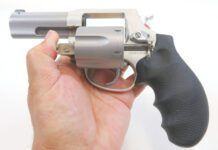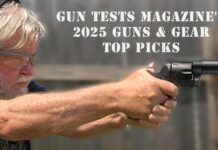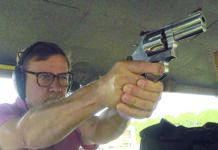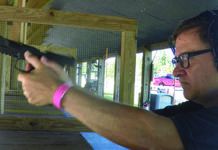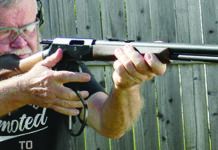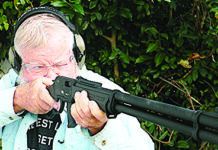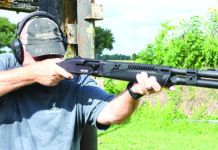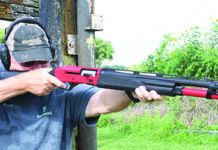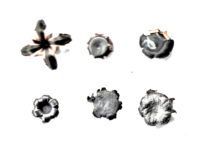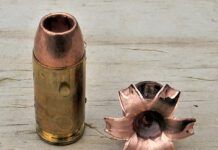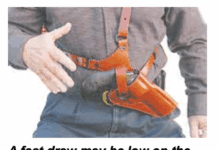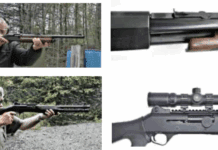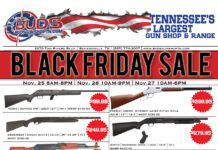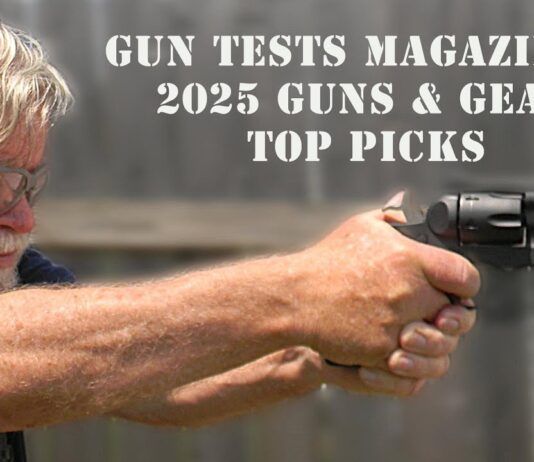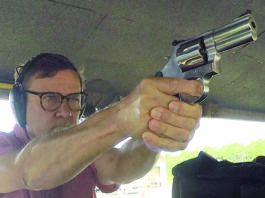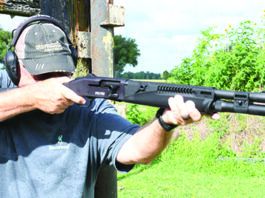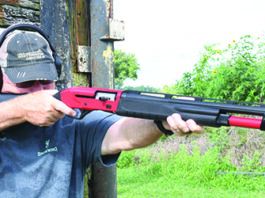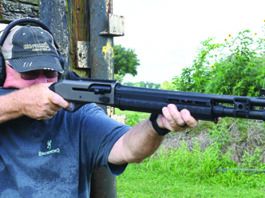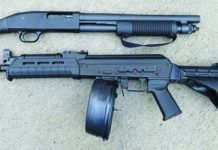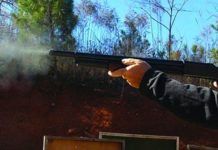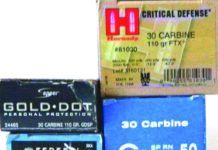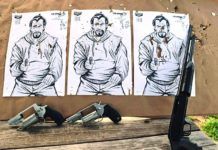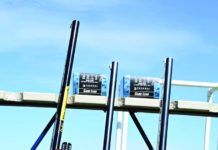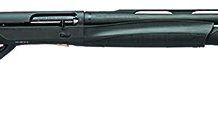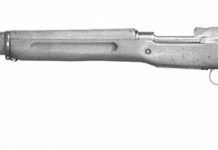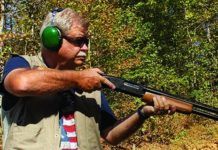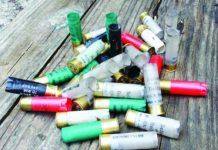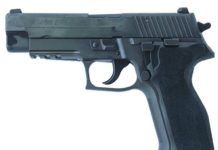Over-the-Counter Exotics from Mossberg and Century Arms
Pumpgun Showdown: Remington 870 Vs. Norincos Wild Bunch
The 12-gauge shotgun remains the most effective home-defense weapon available. While some prefer the handgun for convenience or the 223-chambered rifle for low recoil, all give a nod to the awesome power and simplicity of the pump-action shotgun. The shotgun is also the most common home-defense weapon for non-firearms-passionate individuals. Everyone should learn to use a tool well. But the home-defense shotgun is often treated with the same respect and purpose as the spare tire and jack in the vehicle. If we need it, it is needed badly, but otherwise we tend not to think about it. Non-gun folks, including far north aviators and sailors, keep a shotgun handy just in case they have to deal with angry animals or bad people. As long as the pump-action shotgun is in good repair and functions well, the exact choice may not be as important as the terminal ballistics. But there are differences in handling that are interesting, and every advantage should be taken.
We decided to look at the subject of a number of reader requests for reports on affordable pump-action shotguns. Some used guns are out of production, and others are earlier versions of popular shotguns. Some are just used and only a few months old.
We picked two popular shotguns, including one of the most popular ever made, the Remington 870. We counted this as a good deal. It's very similar to a shotgun Remington still offers through its law enforcement side, the 870P Standard pump action.
We also found a used Norinco Wild Bunch shotgun for $299 at the same outlet. It was as new and also counted a good buy. But that isn't the whole story—they were purchased months apart, one for a backup truck gun and the other as a Wild Bunch Cowboy gun. Naturally, they were thrown together by the raters from time to time, and the question came up about how suitable the Wild Bunch gun was for home defense. The owner answered by saying it was already his favorite home defender despite a safe that held more-modern guns.
When you are looking at older pump-action shotguns, the concerns include maintenance, supply of parts, and perhaps ergonomics. When you look at the handling of the shotguns and the sights, well, it is what it is. There are a few add-ons for the Remington, but we might as well purchase a more highly developed shotgun in the beginning if that is what is desired. So, we stuck with the shotguns as issued and took at hard look at each for personal defense. The results were interesting, and in the end we respect both shotguns, but have greater respect for just one.
Slugs For Self Defense: These Shotgun Rounds Rock
Not long ago a reader asked for a feature on shotgun slugs. He asked for a report on not only the usual fare found in most sporting-good shops, but also the most powerful slugs for personal defense. The standard for many years has been the 1-ounce (437.5 grain) slug at 1500 fps or so. Then the reduced-recoil slugs were introduced for police use and found much popularity among civilian shooters. Some slugs are designed to limit penetration, and there are slugs intended for use in a situation when extra penetration is needed. There are areas in which only shotguns are allowed for hunting, and it is good to have a choice among slugs for long range and large animals. We focused on slugs for home defense and animal defense. As such, there was necessarily a dual rating system, which we noted in each segment. Limited penetration is desirable in most home-defense situations. For use against bears, the greatest penetration is needed. Some of these slugs are accurate well past 50 yards, even 100 yards in a rifled slug barrel. In a proper rifled shotgun barrel, we feel that Lightfield's claims of accuracy to 150 yards would be borne out.
These are big chunks of lead. They produce a considerable wound track whether they expand or not. We took a hard look at these slugs and found interesting performance. We also found a great deal of recoil. As an example, the strongest Lightfield slug measured a 933 power factor. We debated including PF, as it isn't the same thing with a long gun as a handgun, but kept the figures because they are useful for comparing recoil. The heaviest slugs have nearly twice the recoil of the average full-power 30-06 rifle load. Keep this in mind. The test ended with sore shoulders, one broken nail, and quite a bit of use of penetrating ointments! Most folks will not go to the range and fire 40 full-power slugs from a riot gun in one morning. As our former police firearms instructor noted, it isn't about putting down a lot of lead, but you can do that with the reduced-recoil slug. If you need to stop one of the big cats, a feral dog, or a bear, then you need to get on target and make every shot count. The level of energy these shotgun slug loads displayed is impressive.
During the research, we also consulted some who had faced big bears, including grizzlies. One correspondent had not shot a grizzly, but as a young man was given the task of skinning one that has been taken down by Canadian authorities. He told us that they are nothing like a moose or a brownie. The attachment of the sinew, the ligaments, he noted, simply wore out knives and cleavers. It was quite a chore. Large, aggressive animals are very dangerous and very tough. While shotgun slugs have their place against a grizzly, a 375-caliber or larger rifle might be the better choice. Just the same, these slugs gave good performance. For personal defense, the reduced-recoil loads are excellent, while the full-power loads would be effective against cougars and brown bears, not to mention the ever-dangerous feral dog and, the most dangerous, criminals. As for our choice of shotgun for testing, the pump action shotgun is used by many of us for home defense. It is the type of shotgun that would be kept in a light plane in Alaska or the back of a truck just in case. The 18-inch riot gun delivered good performance, we felt, and while the recoil of some of these loads were doubtless more than many would like to handle, the performance on target was also impressive. Velocity was less than the rated velocity of most slugs, as they are designed for use in a 24- to 28-inch barrel hunting shotgun. As one of the raters noted, both the Remington 870 shotgun and a 165-pound rater were fighting out of their weight class firing some of these slugs.
Here's what our shooters and the water jugs said about each round.
30 Carbine Picks: Hornady, Speer, Buffalo Bore Loads Tested
The 30 Carbine cartridge is an interesting and historically significant round. The M1 Carbine was the first little-maintenance firearm issued to the U.S. Army and was also among the first firearms that might correctly be called a Personal Defense Weapon (PDW). Designed for military officers, back-area troops, truck drivers and other personnel not usually armed with a rifle, it was specifically intended to allow officers to carry a lightweight rifle that was more powerful and accurate than a handgun. The carbine was not a short-barrel full-power rifle as earlier carbines had been, being instead designed for a lower-powered cartridge compared to the 30-06 cartridge used in the M1 Garand. Compared to the Russian M44 or the British No. 5 carbine, the M1 carbine is much easier to use well and handle. The M1 Carbine was designed for close-range area defense and personal defense. The concept was successful, and eventually, the army manufactured more than 6 million carbines. Numerous police agencies used the M1 carbine, including post-war Berlin and the NYPD. For close-range battle, the M1 carbine has much to offer.
We feel that the attributes of the M1 Carbine might make it even better suited to home defense than the typical AR-15 rifle. For hunting use and predator control, not so much. We cannot recommend the energy level of the 30 Carbines for deer-sized game, but its low recoil and low muzzle flash are essential for home defense, and the 30 Carbine offers both, but with 357 Magnum energy. The rifle is ergonomic and provides high hit probability. We admit the standard 110-grain FMJ load at about 2000 fps isn't the best choice for home defense, based on over penetration and a lack of wound potential. There have been 110-grain jacketed soft points and jacketed hollowpoints used by police agencies, but most of these loads seem out of production by old mainstays Winchester and Remington. Still, we were able to collect loads using modern expanding bullets and compare them for accuracy penetration and expansion. What we found was that accuracy is good to excellent for all loads, although some were more accurate than others. For use in the home or area defense and animal defense against feral dogs and coyotes to 50 yards or more, the little rifle is plenty accurate. While we find there was something to recommend about all the loads tested, there are standouts. The Buffalo Bore full-power load and the Speer Gold Dot are at the top of the pack for home defense, with the Critical Defense load a strong contender for tactical use.
In this test, we fired 50 cartridges of each load, which included three cartridges each for penetration and expansion testing and fifteen cartridges (three five-shot groups) for accuracy. The remaining 32 rounds were fired in off hand shooting for personal defense work at 5, 7, and 25 yards. We tested accuracy from 25 yards. The rifle was a vintage Israel Arms International carbine. Here are the results.
.410 Bore Self-Defense Choices
The decision of which self-defense .410 firearm is the correct choice for up-close-and-personal situations encountered in the home often comes down to a handgun in one hand or a short-barreled pump-action shotgun in the other. Because of their ease of handling, two revolvers that are capable of firing both .410 loads and handgun rounds are becoming quite popular; and pistol-grip short-barrel shotguns remain a favored option in self-defense circles. The question arises about which type of close-range firearm is the most effective with the diminutive .410 loads, including those that have recently been developed with short-barreled revolvers in mind.
Acting on a reader request, we conducted a multitude of tests on a trio of readily available self-defense firearms that included a Taurus Judge (handles .410-bore shotshells and 45 Colt) that retails for $629; a Smith & Wesson Governor (handles .410, 45 Colt, and 45 ACP) that retails for $809; and a Mossberg Model 500 Cruiser that sells for $467 and fires .410-bore shotshells.
Each of the firearms (all have been examined in previous GT reviews) is specifically designed for close-quarters action, such as when an intruder has illegally entered a residence, placing the people living in the home in a potentially life-threatening situation. In such a life-or-death scenario, a reliable, easy-to-handle, and effective self-defense tool is essential.
In this part of the GT evaluation and match-up, our focus was on the handling ability of the three firearms and their patterning performance at close-quarters ranges. We attempted to walk the fine line that divides ease of handling with putting the pattern in the right place to evaluate the two revolvers and the pump-action.
We tested the firearms on the range with targets set at two ranges used in concealed carry courses to simulate typical home-defense scenarios. The close targets were set at 9 feet (3 yards) and the second set of targets was shot at 21 feet (7 yards). Here are our findings.
Brownings Sweet Sixteen: Still Sweet After All These Years?
The popularity of the 16-gauge shotgun, in particular the Browning A5 Sweet Sixteen, has never waned among those select shooters with a streak of nostalgia in their genetic makeup. A common refrain of, "I've still got my granddad's old 16 — best bird gun ever made," is often heard whenever veteran shooters gather to share tales of old or create new memories of quality time in the outdoors.
Responding to a reader's request, we decided to give the recently unveiled Browning A5 Sweet Sixteen that premiered at the 2016 SHOT Show a closer look to see what motivates the 16 gauge's small, but very loyal, fan base. The new semiautomatic is built with a smaller, lighter receiver than the old-style Humpback and utilizes a different recoil system than the long-recoil creation of legendary firearms genius John M. Browning, so only time will tell if it has the lasting power of its predecessors.
The Light Twelve was added to the mix for a couple of reasons. First, the older Sweet Sixteen is built on the same-sized frame as the 12 gauge. Also, we wanted to see if the 16 gauge lives up to its reputation as a more sporting shooting tool. And, of course, 12-gauge ammunition is much more available than 16-gauge shotshells, and if the potential wingshooter is in the market for one of these Humpbacks, how much will nostalgia and pride of ownership of a "Sweet Sixteen" override the economics of shooting the bigger gauge, assuming similar performance?
New Shotguns at SHOT 2017
At the 2017 SHOT Show in Las Vegas, versatility best explains the new offerings for this year. Manufacturers are building new pursuit-driven shotguns and tweaking current offerings to provide even more niche specialization of their products. It doesn't matter whether you're looking for a duck-blind gun or a behind-the-truck-seat compact scattergun, there is no lack of diversity in the shotgun category this year.
Trump’s Gun Agenda and Gun Tests’ Glossy New Look
Dear Mr. Woodard: First, let me compliment you on the continued publication of your fine magazine! Just read your editorial concerning the presidential election. I don't know how many people understand how clear the correlation between Ms. Clinton's vehement anti-2A views and her loss of what should have been a slam-dunk win. If the numbers are remotely correct, there are 80 million gun owners in America. This number presumes that most of those folks are adults and not felons; therefore, they were potential voters. Another stat says that roughly 1 out of 20 Americans have a concealed-carry permit.
Budget 20-Gauge Shoot Off: H&R, Century, and Mossberg
The shotgun can be an important part of the home-defense firearms collection. The scattergun offers excellent hit probability and provides a formidable option for those concerned with home invasions. The wisdom of such preparedness is reflected in the headlines every day. We live in a dangerous world. The problem is, many of us are on a budget and cannot afford a thousand-dollar tactical shotgun. Others are recoil shy or have a physical impairment that makes firing the mighty 12 gauge difficult. Even some who may be able to handle the 12 well will find the light and fast-handling 20 gauge has appeal.
In this installment, we test three affordable 20-gauge shotguns. The 20 gauge was chosen because, while generating about half the recoil of the 12 gauge, it has a little more than half the payload, which considering the ample power of the shotgun, seems to be a reasonable trade off. Even better for the tests, as it turns out the shotguns were choked Open, Modified and Full, giving us a unique opportunity to compare chokes and how they affect shot spread at home-defense ranges. After weeks of searching, we found three shotguns at or under $300. These included the Century International Arms JW-2000 double-barrel coach gun, a Mossberg 20-gauge pump, and an H&R Pardner single shot. Some may scoff at the idea of even considering the single shot or double barrel for home defense, but we found that while they might not be ribeye, they aren't chopped liver if used properly.
Shotgun Shootout: Self-Loader, Pump, or Dual-Action Design?
When we decided to test three tactical shotguns suitable for home defense, rather than test three pumps or three self-loaders, we tested one of each, and one that could be either. The Benelli Nova Tactical Pump was our first type, followed by a semi-auto Mossberg 930 Tactical and TriStar's TEC-12, the latter of which can operate as a pump or semi-auto. If we were jumping into the sandbox at the moment, we think the Benelli M3 might be our choice, especially after firing the near clone of it, the TEC-12. However, the team thought the Benelli Nova pump had the simplest action to use well, and for us, its performance could not be faulted. The Mossberg 930 Tactical had its advantages as well, among them being it was the most comfortable shotgun to fire and use. We had our preference, as we describe below, but you may decide one of the others is better for you. To make that decision easier, our shooters went over the three guns with an eye toward finding flaws, and before we begin in earnest, we will say we found few problems, and that any of these three would do good duty for home defense.
We have had generally good luck with Benelli's Nova variations over the years. Way back in July 2007, we tested the field-grade Benelli Nova Pump 12 Gauge and gave it an "A-" for its overall performance, the feel and function of the synthetic stock and forearm, and its selection of choke tubes, which was impressive for this bargain-priced firearm. Then in the October 2013 issue, we tested a Benelli Super Nova Tactical No. 29155 12 Gauge. That gun earned an "A-" grade, losing out to a less expensive Stevens 320 that was every bit as good as the Super Nova and hundreds of dollars cheaper. Also, that Tactical Super Nova was the heaviest of those shotguns, which can be good or bad depending on the shooter and the load. But in that test, our shooters particularly liked the feel of the grooved polymer forearm and pistol grip. Downside: The out-of-the-box trigger pull of 8.75 pounds was too hefty for our tastes. Functionally, however, the Super Nova was fine. Those same likes carry over to a Benelli Nova H2O, which features a nickel-plated barrel, that we have not worked into a head-to-head against other corrosion-resistant units. Functionally, it has felt and operated like the other Novas we've tested, but the unit we've been shooting off and on (No. 20090, $669 MSRP) for a couple of years has open rifle sights (blade front and rear notch), which we don't like as well as the Ghost Ring sight on the Nova Tactical, and the price is a big step up from the plain black Benelli. At the time of this test, GanderMountain.com listed the H2O at $650, not including shipping and other charges such as FFL receiving fees. If you need the anti-corrosion features, you may be willing to pay the premium price for it, but for us, because of the price and the sights, we'd have to call the H2O a "B" in terms of value.
2016 Guns & Gear Top Picks
Toward the end of each year, I survey the work R.K. Campbell, Roger Eckstine, Austin Miller, Robert Sadowski, David Tannahill, Tracey Taylor, John Taylor, Rafael Urista, and Ralph Winingham have done in Gun Tests, with an eye toward selecting guns, accessories, and ammunition the magazine's testers have endorsed. From these evaluations I pick the best from a full year's worth of tests and distill recommendations for readers, who often use them as shopping guides. These choices are a mixture of our original tests and other information I've compiled during the year. After we roll high-rated test products into long-term testing, I keep tabs on how those guns do, and if the firearms and accessories continue performing well, then I have confidence including them in this wrap-up.
Correcting The H&R Single Shots Problems
Harrington and Richardson made single-barrel shotguns for more than 100 years, and the basic design didn't change when New England Arms took over. The shotgun action we will use for this chapter is from one of the company's latest model series.


